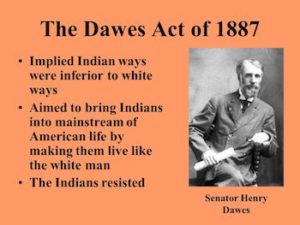
*On this date, in 1887, The Dawes Act was passed. Named after white-American Senator Henry L. Dawes of Massachusetts, it is also known as the General Allotment Act or the Dawes Severalty Act.
The intersectionality between African Americans and Native Americans was affected by this legal episode. It authorized the President of the United States to subdivide Native American tribal landholdings into allotments for Native American heads of families and individuals, transferring traditional land tenure into government-imposed systems of private property systems.
This forced Native Americans to "assume a capitalist and proprietary relationship with property" that did not previously exist. The act also opened the remaining Native land for appropriation by white settlers. Before private property could be dispensed, the government had to determine "which Indians were eligible" for allotments, which propelled an "official search for a federal definition of Indian-ness."
Although the Dawes Act was passed in 1887, the federal government implemented it "on a tribe-by-tribe basis" thereafter. For example 1895, Congress passed the Hunter Act, which administered Dawes "among the Southern Ute." The nominal purpose of the act was to protect "the property of the natives" and compel "their absorption into the American mainstream." Native peoples deemed "mixed-blood" were forced to accept U.S. citizenship, while others were "detribalized."
Between 1887 and 1934, Native Americans "lost control of about 100 million acres of land" or about "two-thirds of the land base they held in 1887" due to the act. The loss of land and the adverse effects of Dawes have prompted scholars to refer to the act as one of the most destructive U.S. policies for Native Americans in history.
The "Five Civilized Tribes" (Cherokee, Chickasaw, Choctaw, Muscogee, and Seminole) and their Freedmen and Freedwomen were initially exempt from the Dawes Act. This resulted in the creation of the Dawes Commission in 1893, a delegation that defined tribal belonging in terms of blood quantum.
The Curtis Act extended the provisions of the Dawes Act into the Indian Territory, which had a sizable group of Blacks within the Cherokee, Choctaw, Chickasaw, Creek, and Seminole tribes. Many of these freedmen had their communities within the various tribes. However, because there was no method of determining precise bloodlines, commission members often assigned "full-blood status" to Native Americans who were perceived as "poorly assimilated" or "legally incompetent" and "mixed-blood status" to Native Americans who "most resembled whites."